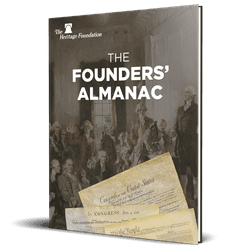Members of Congress soon will have the opportunity to improve the future for poor children across the United States when they consider Helping Empower Low-Income Parents (HELP) Scholarships. Introduced by Representatives James Talent (R_MO), J. C. Watts (R-OK), Floyd Flake (D-NY), and Frank Riggs (R-CA), this legislation would provide states tools and funding to offer low-income, inner-city parents the opportunity to educate their children in safe and academically challenging schools of their personal choice.
The "HELP Scholarships" program would permit states to use existing Innovation in Education block grants under Title VI of the Elementary and Secondary Education Act to implement or enhance existing school choice programs through scholarships for inner-city students. The funding would go to school choice programs that benefit those families with incomes at or below 185 percent of the poverty level. The value of each scholarship would be set at no more than the per-pupil public school expenditure in that locality and no less than 60 percent of the per-pupil expenditure or the cost of private tuition, whichever is less. These scholarships would be redeemable at any private, public, or religious school of the parents' choice. In this legislation, Congress has an opportunity to encourage states to adopt additional educational opportunities for the poorest children in the country.
Help for Communities and Parents
The HELP Scholarships bill would allow the states flexibility
in utilizing Title VI funding for implementing statewide,
city-wide, or district-wide school choice programs. Title VI
dollars ($310 million for fiscal year 1997) reach the states with
few mandates attached, and the communities are given wide latitude
in determining the ways in which to use them. The states and
localities that implement a HELP-style choice program in turn would
empower low-income families by giving them the opportunity to
select their children's school. Studies consistently demonstrate
that engaging parents in their children's education has been the
strongest factor in raising academic achievement. HELP Scholarships
would facilitate this important link between low-income parents and
their children's education.
Help for Low-Income Students
Two well-known school choice initiatives provide insight into
the ways in which school choice benefits inner-city children. The
Milwaukee plan gives vouchers to low-income children to attend a
public or private non-religious school of their choice, and the
Cleveland plan gives vouchers to poor children to attend a private
or religious school of choice. Recent studies of the these school
choice programs offer concrete evidence that choice helps
the urban poor. Studies by Paul Peterson of the John F.
Kennedy School of Government at Harvard University and Jay Greene
of the Center for Public Policy at the University of Houston found
that the Milwaukee and Cleveland school choice programs benefit
minority inner-city students the most. The Milwaukee study shows
that, after just three years in operation, the gap between the test
scores of white students and those of African-American and Hispanic
students narrowed by 33 percent to 50 percent. (In a similar study,
Cecilia Rouse from Princeton University found identical results
with students' math test scores.)
Peterson and Greene found that school choice in Cleveland raised the scores of the students tested at the end of the first year and was very popular with parents. In fact, two-thirds of the parents whose children received vouchers to attend private or parochial school were "very satisfied" with the academic quality of the school they chose; only 30 percent of the parents who were unable to use a voucher expressed satisfaction with their children's schools. Parents in the choice program were twice as likely to be happy with other aspects of the schools they chose, such as discipline, class size, and teachers.
Studies of the existing 33 private scholarship programs throughout the country point to similar results in academic improvement.
Help for Public Schools
Using HELP Scholarships to implement a choice program would not
pull money away from public schools. In fact, use of these
scholarships would help relieve overcrowding in public school
classrooms and leave funds behind in the public schools for the
remaining students. Milwaukee, with the first school choice program
in the country, already sees positive effects on its public schools
from its school choice program. John Gardner, an at-large member of
the Milwaukee Public Schools Board of Directors, noted recently
that the "Milwaukee Public Schools' (MPS) internal reforms required
the sustained challenge and competition of the Milwaukee Parental
Choice Program. The [Parental Choice] program...puts effective
pressure on MPS to expand, accelerate, and improve reforms long
deliberated and too-long postponed."
Using choice to relieve overcrowding is an option that has been implemented in Houston, Texas, at district expense. When the city's voters rejected a $390 million bond measure in May 1996 to build 15 new schools and renovate 84 existing ones, Superintendent Rod Paige turned to the private sector for help. Paige offered to place students from an estimated 65 overcrowded schools in area private schools at district expense instead of busing them to distant public schools. Soon thereafter, the Houston school trustees voted unanimously on a plan to give parents in the Houston Independent School District expanded educational choices.
Economist Caroline M. Hoxby of Harvard University studied the effectiveness of school choice programs and found that competition from private schools increased academic achievement in both public and private schools. And greater private school competitiveness not only raised the academic quality of public schools, but also high school graduation rates and future wages of public school students. Hoxby also found that public schools reacted to this competition by increasing their teachers' salaries. Both public and private school children increased the amount of time in school by about two years while improving their math and reading test scores by about 10 percent. In addition, Hoxby found a 14 percent increase in wages for both public and private school students.
Improving Educational Opportunity
Establishing HELP Scholarships would enable states to use
federal funds to increase educational opportunities for inner-city
poor children while protecting funding for public schools. Thanks
to HELP Scholarships, Members of Congress who care about preserving
local and state control of education as well as improving the
dismal academic record of inner-city students can promote a policy
that addresses both problems. This legislation is a step in the
right direction. A program that offers incentives to states and
localities to empower poor parents directly so they can choose the
best educational setting for their children would be superior to
one that merely allows the states and localities the option
to help those parents. Unless states and localities first implement
school choice programs, this bill will not help thousands of poor
children trapped in failing public schools. But it has the
potential to assist those states that create or already have school
choice programs in place.




